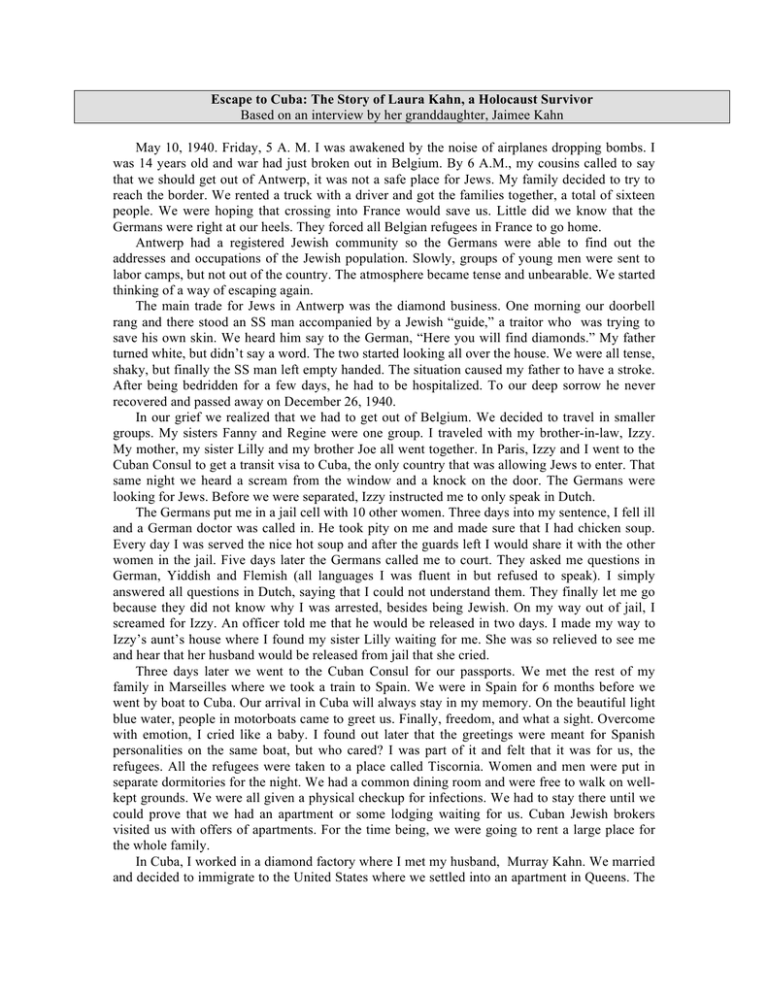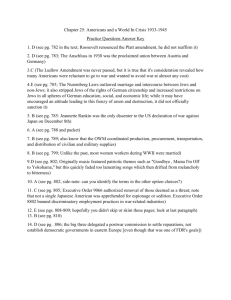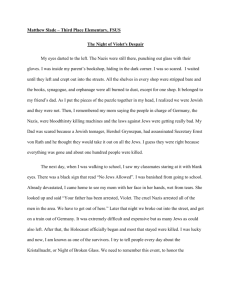Escape to Cuba: The Story of Laura Kahn, a Holocaust... Based on an interview by her granddaughter, Jaimee Kahn
advertisement

Escape to Cuba: The Story of Laura Kahn, a Holocaust Survivor Based on an interview by her granddaughter, Jaimee Kahn May 10, 1940. Friday, 5 A. M. I was awakened by the noise of airplanes dropping bombs. I was 14 years old and war had just broken out in Belgium. By 6 A.M., my cousins called to say that we should get out of Antwerp, it was not a safe place for Jews. My family decided to try to reach the border. We rented a truck with a driver and got the families together, a total of sixteen people. We were hoping that crossing into France would save us. Little did we know that the Germans were right at our heels. They forced all Belgian refugees in France to go home. Antwerp had a registered Jewish community so the Germans were able to find out the addresses and occupations of the Jewish population. Slowly, groups of young men were sent to labor camps, but not out of the country. The atmosphere became tense and unbearable. We started thinking of a way of escaping again. The main trade for Jews in Antwerp was the diamond business. One morning our doorbell rang and there stood an SS man accompanied by a Jewish “guide,” a traitor who was trying to save his own skin. We heard him say to the German, “Here you will find diamonds.” My father turned white, but didn’t say a word. The two started looking all over the house. We were all tense, shaky, but finally the SS man left empty handed. The situation caused my father to have a stroke. After being bedridden for a few days, he had to be hospitalized. To our deep sorrow he never recovered and passed away on December 26, 1940. In our grief we realized that we had to get out of Belgium. We decided to travel in smaller groups. My sisters Fanny and Regine were one group. I traveled with my brother-in-law, Izzy. My mother, my sister Lilly and my brother Joe all went together. In Paris, Izzy and I went to the Cuban Consul to get a transit visa to Cuba, the only country that was allowing Jews to enter. That same night we heard a scream from the window and a knock on the door. The Germans were looking for Jews. Before we were separated, Izzy instructed me to only speak in Dutch. The Germans put me in a jail cell with 10 other women. Three days into my sentence, I fell ill and a German doctor was called in. He took pity on me and made sure that I had chicken soup. Every day I was served the nice hot soup and after the guards left I would share it with the other women in the jail. Five days later the Germans called me to court. They asked me questions in German, Yiddish and Flemish (all languages I was fluent in but refused to speak). I simply answered all questions in Dutch, saying that I could not understand them. They finally let me go because they did not know why I was arrested, besides being Jewish. On my way out of jail, I screamed for Izzy. An officer told me that he would be released in two days. I made my way to Izzy’s aunt’s house where I found my sister Lilly waiting for me. She was so relieved to see me and hear that her husband would be released from jail that she cried. Three days later we went to the Cuban Consul for our passports. We met the rest of my family in Marseilles where we took a train to Spain. We were in Spain for 6 months before we went by boat to Cuba. Our arrival in Cuba will always stay in my memory. On the beautiful light blue water, people in motorboats came to greet us. Finally, freedom, and what a sight. Overcome with emotion, I cried like a baby. I found out later that the greetings were meant for Spanish personalities on the same boat, but who cared? I was part of it and felt that it was for us, the refugees. All the refugees were taken to a place called Tiscornia. Women and men were put in separate dormitories for the night. We had a common dining room and were free to walk on wellkept grounds. We were all given a physical checkup for infections. We had to stay there until we could prove that we had an apartment or some lodging waiting for us. Cuban Jewish brokers visited us with offers of apartments. For the time being, we were going to rent a large place for the whole family. In Cuba, I worked in a diamond factory where I met my husband, Murray Kahn. We married and decided to immigrate to the United States where we settled into an apartment in Queens. The entire community was European Jews at that time and it reminded us of life back in Europe before the war. Questions 1. Why was Europe unsafe for Jews? 2. Describe the circumstances leading up to Laura’s father’s death? 3. Why do you think Laura’s brother -in-law told her to speak only Dutch? 4. Why did the family go to Cuba? High School Level Activities: Rescuers and Resistance (prepared by Jaimee Kahn, Farmingdale HS, Farmingdale, NY) A. Resistance During the Holocaust (Source: The United States Memorial Museum Resource Guide) “From the Nazis’ rise to power in 1933 in Germany to the end of the Third Reich in 1945, Jews …as well as other victims of Nazism, participated in many acts of resistance. Organizedarmed resistance was the most direct form of opposition to the Nazis. In many areas of Germanoccupied Europe, resistance took other forms such as aid, rescue, and spiritual resistance. Resistance by partisan fighters using “hit-and-run” guerrilla tactics during the war provides an important and necessary context for understanding the limits and possibilities of Jewish resistance during the Holocaust. But one should not confuse partisan resistance to the German military effort and the German occupation of Europe, on the one hand, with Jewish resistance, on the other, even though the two sometimes overlapped. . . . As the victims of Nazi genocide and an isolated, often scorned, minority among occupied populations, Jews were in a distinctively weak situation. Because they were doomed to destruction, they could not wait for the beginning of the German collapse in 1943 to act, as the nationalist and patriotic anti-Nazi resistance movements generally did. By the end of 1942, more than four million Jews had already been killed by mass shootings and gassings, or had died from starvation, exhaustion, and disease during their internment in Nazi ghettos and concentration and forced labor camps. Nazi methods of deception and terror and the superior power of the German police state and military severely inhibited the abilities of civilians in all occupied countries to resist. But the situation of Jews was particularly hopeless, and it is remarkable that individuals and groups resisted to the extent they did. In addition to many acts of unarmed resistance in the ghettos and camps and the armed and unarmed resistance of Jewish partisans operating underground in both eastern and western Europe, armed Jewish resistance took place in 5 major ghettos, 45 small ghettos, 5 major concentration and extermination camps, and 18 forced labor camps. With few exceptions (notably three major uprisings by partisans in late summer 1944 in Warsaw, Paris, and Slovakia as Allied liberators approached), Jews alone engaged in open, armed resistance against the Germans. They received little help from anyone on the outside. . . . Courageous young men and women facing certain death had little to lose.” A. Obstacles to military resistance by Eastern European Jews: 1. Superior, armed power of the Germans 2. German tactics of “collective responsibility” (entire families and communities were responsible for individual acts of resistance and thus would be punished as a whole) 3. Isolation of Jews and lack of weapons 4. Secrecy and deception of deportation by the Germans B. Spiritual Resistance in the Ghettos and Concentration Camps by Eastern European Jews: 1. Underground schools and libraries to learn religious and secular subjects 2. Documenting the Holocaust and the world around them as evidence of the horrors taking place 3. Cultural activities such as the creation of works of art, songs, theatrical productions, concert, cabarets and lectures. One such place was Theresienstadt where adult had young children write poems and paint pictures to psychologically deal with the world around them. 4. Clandestine prayer (secret prayer) Questions 1. Why was armed resistance to the Nazis by Eastern European Jews so difficult? 2. What other ways did Eastern European Jews resist during the Holocaust? 3. Write a poem or design a plaque or exhibit to commemorate Eastern European Jewish resistance? B. Appeal to Resistance in the Warsaw Ghetto, January 1, 1942 (Source: R. Ainsztein, Jewish Resistance in Nazi-Occupied Eastern Europe, NY: Barnes and Noble, 1974) Let us not go to slaughter like sheep! Jewish youth, do not trust the deceivers. Of the 80,000 Jews in Jerusalem of Lithuania only 20,000 remain. With our own eyes we saw our parents, brothers and sisters snatched away forever. Where are the hundreds of men arrested by the police supposedly to do some job of work? Where are the naked women and children taken away in the horrifying night of the great provocation? Where are the Jews captured on Yom Kippur? And where are our brothers who were locked up in the Second Ghetto? Those who were taken from the ghetto will never come back, for all roads from the Gestapo lead to Ponary. And Ponary means death! Cast off the illusions of people blinded by despair: your children, your wives, your husbands are no more! Ponary is no camp. They have all been shot. Hitler has invented a system for the destruction of all the Jews in Europe. It has been our fate to be the first. Let us not go like sheep to slaughter! It is true that we are weak and we have nobody to help us. But our only dignified answer to the enemy must be resistance! Brothers, it is better to die like free fighters than to live by the murderer’s grace. Resist until your last breath! Questions 1. Why are the Jews of the Warsaw Ghetto being called on to resist the Nazis? 2. Why does the appeal demand that Jews not act like “sheep”? 3. The “Appeal” ends with the statement, “Brothers, it is better to die like free fighters than to live by the murderer’s grace. Resist until your last breath!” Do you agree or disagree? Why? 4. If you were in Warsaw, would you have joined the resistance? Explain. C. A Rescuer Named Fiodor Kichailovitch Kalenczuk (Source: The Record: Holocaust in History, 1933 - 1945, The Anti-Defamation League of B’nai B’rith and The National Council for the Social Studies) “On a tree in Jerusalem is the name Fiodor Kichailovitch Kalenczuk. Four Jews from the Ukraine survived the war because Kalenczuk, at peril to himself and his family, hid them on his farm for seventeen long months. The Jewish survivors were Pessah Kranzberg, a grain merchant form the town of Hoszcza, his wife, his 10-year-old daughter Rassia, and Rassia’s little friend Miriam. In 1942 the Nazi invaders marched across Poland and Russia. Kranzberg and the others managed to escape from the burning ghetto in Hoszcza and fled to Kalenczuk’s farm. The two men had known, respected and liked each other for five years; never imagining what dark days would come. When the world around the Kranzbergs collapsed, Kalenczuk came forth with support. First he sheltered the fugitives in is own home. Then he fashioned a secure hiding place for them in his stable, bringing them meals three times a day, taking care to provide only kosher food. Kalenczuk himself had to struggle to support his wife and eight children. In 1943 he had to surrender part of his harvest to the Germans, yet he continued to feed the four who were hiding in his stable. His wife feared that the Jews were endangering a Christian household. But he refused to deny them refuge. At last, in January 1944 the Red Army advance made it safe for the Kranzbergs and little Miriam to leave their hiding place. Eventually they reached Israel. And one day in 1967 Fiodor Michailovitch Kalenczuk stood with them in Jerusalem at the ceremony enshrining his name in the Garden of the Righteous.” Questions 1. What did Fiodor Kalenczuk do for Pessah Kranzberg, his family and friend? 2. What could have happened to Fiodor Kalenczuk if the Nazis had caught him? 3. Write a report about the Garden of the Righteous at Yad Vashem in Jerusalem. 4. Write a poem or design a plaque or exhibit to commemorate Fiodor Kalenczuk or another rescuer.




